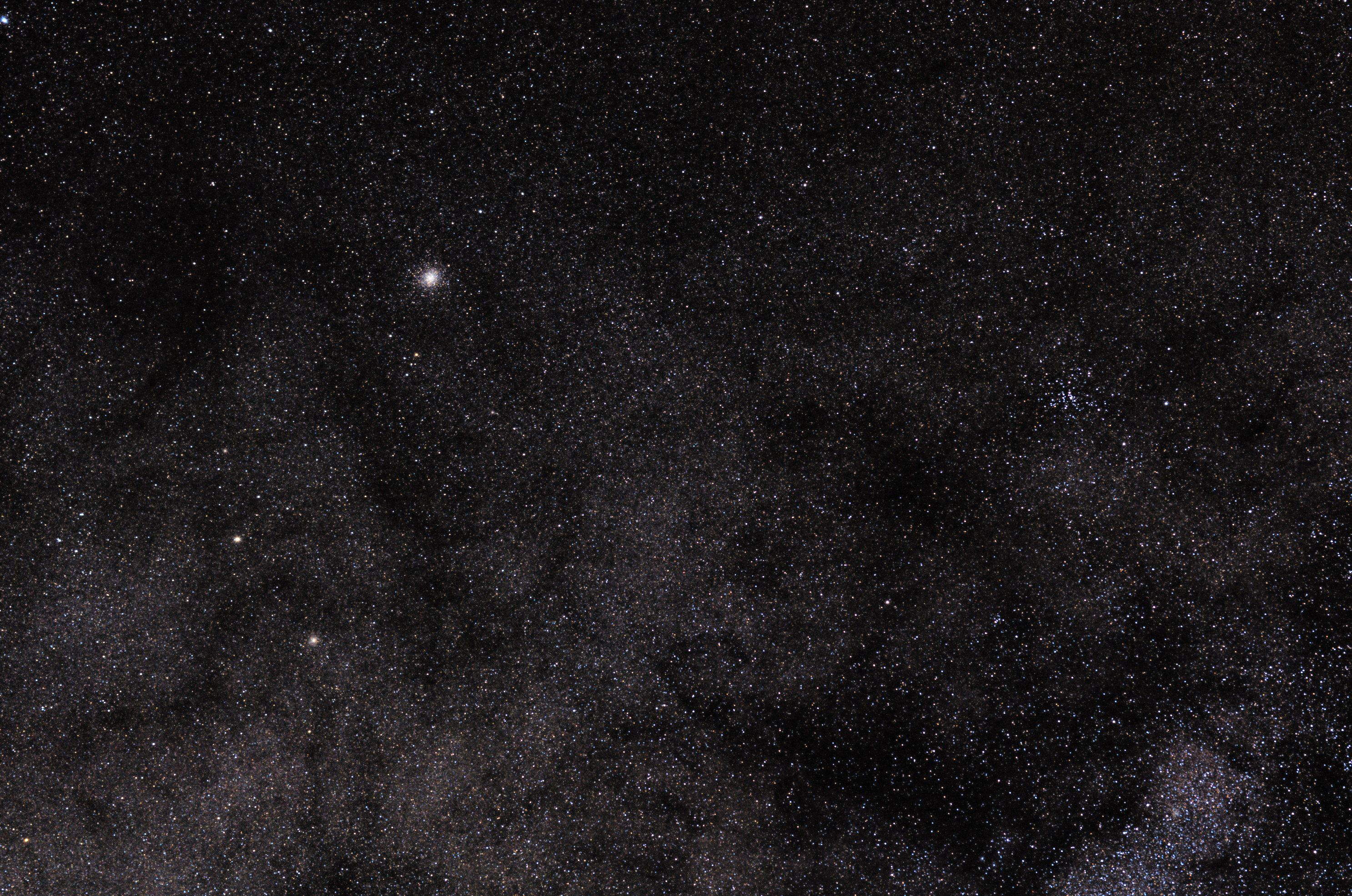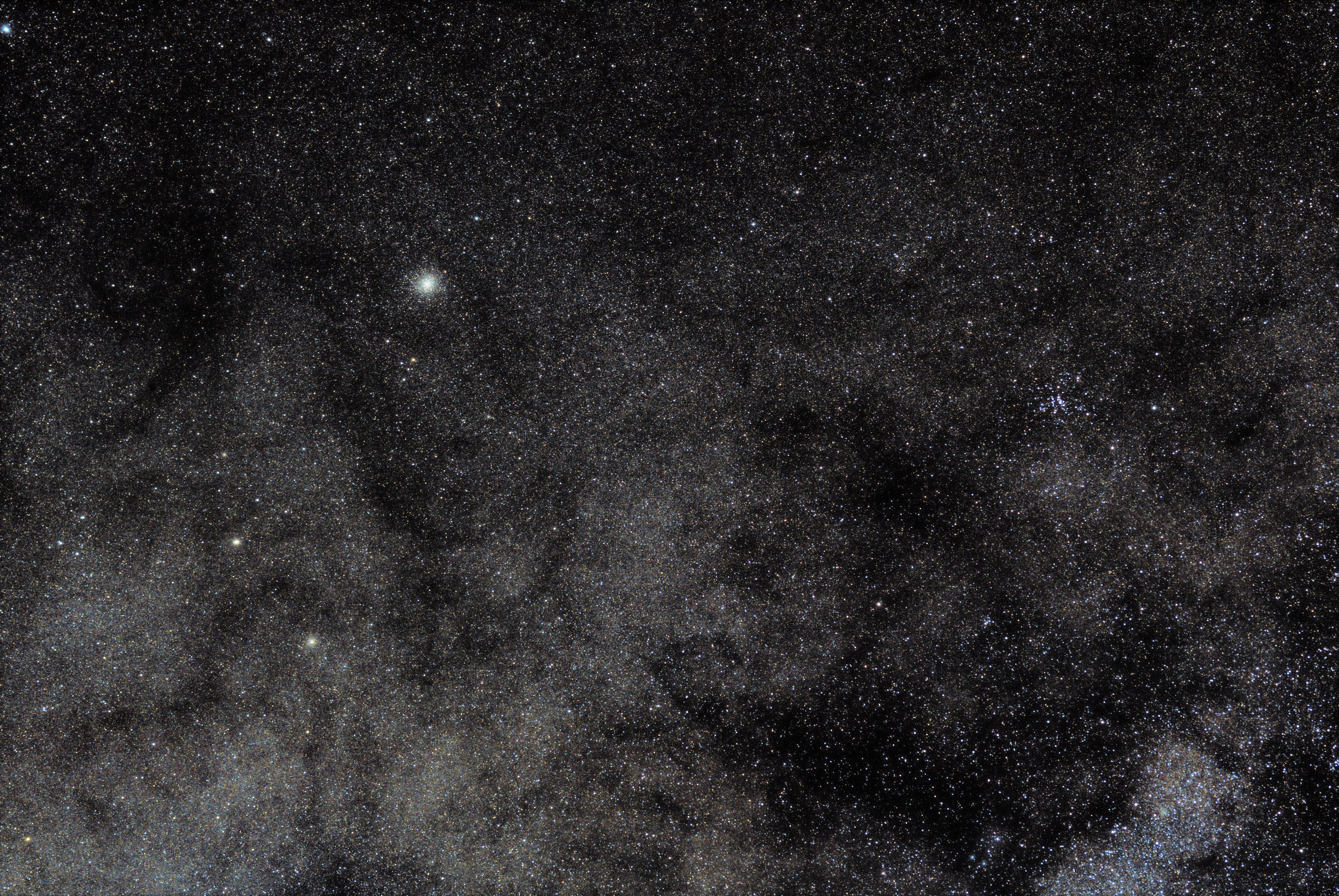Processing star clusters with galactic core
-
celeron787
- Posts: 20
- Joined: Sat Dec 28, 2019 7:09 am
Processing star clusters with galactic core
Need some help processing star clusters in the galactic core.
I managed to get satisfactory colors for M22 and M25 but the colors of the galactic core seems washed out or pale.
I'm aware that more integration time is better judging by the low amount of light frames, but is there any way to pull out the yellow of the galactic core?
FTS file: https://www.dropbox.com/s/amrg7p0vod9zj ... 2.fts?dl=0
Bortle 8-9 zone
Tracked with star adventurer
Sony a6000
Samyang 135mm F2
ISO400
Lights: 14 x 15secs
Darks: 30 x 15secs
Flats: 33
Bias: 50
I managed to get satisfactory colors for M22 and M25 but the colors of the galactic core seems washed out or pale.
I'm aware that more integration time is better judging by the low amount of light frames, but is there any way to pull out the yellow of the galactic core?
FTS file: https://www.dropbox.com/s/amrg7p0vod9zj ... 2.fts?dl=0
Bortle 8-9 zone
Tracked with star adventurer
Sony a6000
Samyang 135mm F2
ISO400
Lights: 14 x 15secs
Darks: 30 x 15secs
Flats: 33
Bias: 50
Re: Processing star clusters with galactic core
Hi,
A couple of things;
For correct Deep Sky Stacker settings, have a look here;
https://www.startools.org/links--tutori ... r-settings
Please also have a look here;
https://www.startools.org/links--tutori ... -and-donts
For example, turn off white balancing by DSS and please stop drizzling; there is absolutely not need for it as your dataset is already oversampled. It just hurts your signal, takes an incredible amount of time to process and creates *massive* datasets (1.2GB!) for no good reason.
The stars in a galactic star field (as well as many clusters) are not all one color. They will/should exhibit a random selection of colors spanning the full blackbody radiation curve, from red > orange > yellow > white > blue. You may see some slight hints of purple due to chromatic aberration in your lens around very bright stars. Once you got the right DSS settings dialled in, color calibration should be easier.
Color balance was;
Parameter [Blue Bias Reduce] set to [1.00]
Parameter [Green Bias Reduce] set to [1.55]
Parameter [Red Bias Reduce] set to [1.88]
Hope this helps!
A couple of things;
For correct Deep Sky Stacker settings, have a look here;
https://www.startools.org/links--tutori ... r-settings
Please also have a look here;
https://www.startools.org/links--tutori ... -and-donts
For example, turn off white balancing by DSS and please stop drizzling; there is absolutely not need for it as your dataset is already oversampled. It just hurts your signal, takes an incredible amount of time to process and creates *massive* datasets (1.2GB!) for no good reason.
The stars in a galactic star field (as well as many clusters) are not all one color. They will/should exhibit a random selection of colors spanning the full blackbody radiation curve, from red > orange > yellow > white > blue. You may see some slight hints of purple due to chromatic aberration in your lens around very bright stars. Once you got the right DSS settings dialled in, color calibration should be easier.
Color balance was;
Parameter [Blue Bias Reduce] set to [1.00]
Parameter [Green Bias Reduce] set to [1.55]
Parameter [Red Bias Reduce] set to [1.88]
Hope this helps!
Ivo Jager
StarTools creator and astronomy enthusiast
StarTools creator and astronomy enthusiast
-
celeron787
- Posts: 20
- Joined: Sat Dec 28, 2019 7:09 am
Re: Processing star clusters with galactic core
Thanks Ivo! I was wondering why was the file size so huge. I have another question. There's another bilinear option under the alignment tab in stacking parameters. Do I leave that as automatic or bilinear?
Re: Processing star clusters with galactic core
It's probably safe to leave it at automatic - not sure what it does...celeron787 wrote:Thanks Ivo! I was wondering why was the file size so huge. I have another question. There's another bilinear option under the alignment tab in stacking parameters. Do I leave that as automatic or bilinear?
Ivo Jager
StarTools creator and astronomy enthusiast
StarTools creator and astronomy enthusiast
-
celeron787
- Posts: 20
- Joined: Sat Dec 28, 2019 7:09 am
Re: Processing star clusters with galactic core
Thanks Ivo.
I managed to re-stack it in DSS with the recommended settings.
FTS file here is anyone would like to give it a go: https://www.dropbox.com/s/gdb9df127mugr ... 4.fts?dl=0
Here's my take at it with some additional adjustments in Lightroom.
I managed to re-stack it in DSS with the recommended settings.
FTS file here is anyone would like to give it a go: https://www.dropbox.com/s/gdb9df127mugr ... 4.fts?dl=0
Here's my take at it with some additional adjustments in Lightroom.
Re: Processing star clusters with galactic core
That's great. It's starting to tend a little to the (incorrect) "everything-is-yellow" renderings of yesteryear though.
That'd be a shame, as you picked up detail across many different wavelengths (I can see Hydrogen-alpha signal starting to poke through for example). Space is an extremely colorful place!
What exactly did you do in Light Room (and why did you feel you needed it?)
That'd be a shame, as you picked up detail across many different wavelengths (I can see Hydrogen-alpha signal starting to poke through for example). Space is an extremely colorful place!
What exactly did you do in Light Room (and why did you feel you needed it?)
Ivo Jager
StarTools creator and astronomy enthusiast
StarTools creator and astronomy enthusiast
-
celeron787
- Posts: 20
- Joined: Sat Dec 28, 2019 7:09 am
Re: Processing star clusters with galactic core
Ah, so I kinda over-processed it lol.
I did some highlights and color adjustment, pushed the yellows and orange in Lightroom as my stars were mostly purplish. Oh I also used photoshop for star reduction, the shrink stars module gave me a very blotchy and mottled result.
Would you mind giving the data a go, would love to see your processing log, I'm still have much to learn
I did some highlights and color adjustment, pushed the yellows and orange in Lightroom as my stars were mostly purplish. Oh I also used photoshop for star reduction, the shrink stars module gave me a very blotchy and mottled result.
Would you mind giving the data a go, would love to see your processing log, I'm still have much to learn
Re: Processing star clusters with galactic core
No problem. The biggest thing to understand about post-processing for AP, is that, if you are familiar with image processing for terrestrial purposes, any techniques or programs you may have used for that purpose are mostly not applicable. That is, if you're interested more interested in scientifically useful/correct photography rather than 90s album cover artceleron787 wrote:Ah, so I kinda over-processed it lol.
I did some highlights and color adjustment, pushed the yellows and orange in Lightroom as my stars were mostly purplish. Oh I also used photoshop for star reduction, the shrink stars module gave me a very blotchy and mottled result.
Would you mind giving the data a go, would love to see your processing log, I'm still have much to learn
Every module in ST has AP-specific functionality. Rather than jumping into PS, The GIMP or Lightroom. And if something isn't there at first glance, ask the question why it may not be there. Sometimes it is there, just in a form that is AP-friendly), or just might not work in the way you thought it would.
--- AutoDev
Tto see what we got. We can see eggy stars. Gradient. Tiny stacking artefacts left and top.
--- Bin
Bin 50%
--- Crop
3 pixels off all borders (just to be safe)
--- Wipe
Default settings
--- AutoDev
Final global stretch
RoI over M22
X1 907, X2 995, Y1 600, Y2 668
(optional) --- Life
Isolate preset (which is default settings). This re-emphasises larger scale structures. May take a while to compute.
--- Decon
Instead of shrinking stars, let's try to coalesce them back into point-lights.
Conservative Mask.
Primary radius 1.2 pixels.
Note in particular the recovery of stars in M22 and M28.
I won't bore you with how crazy/amazing it is that Decon is able to do all this on a heavily processed image.
--- Color
Default settings, however with Cap Green set to 100%.
The average color of the milky way is... milky (white).
The Sample button samples all pixels in the mask (by default all pixels) and sets the Bias parameters in such a way that the average color becomes white.
It does this on launch too and that is how it got its default Bias multipliers for your image. In other words, these values should be roughly correct already for a <ilkyway shot. Things that can throw off this assumption/detection is severe chromatic aberration - yours is only minor and further helped by preparing and importing the dataset as not color balanced.
It is also possible to apply the camera matrix for your A6000, however this seems to make things (e.g. chromatic aberration) quite a bit worse in your case. In general applying your camera manufacturer's color correction matrix (meant for terrestrial purposes) does not help a whole lot in AP (it tends to exaggerate reds mostly). There is a reason why OSCs don't have them. Without applying the matrix, your color rendition will look like that of an OSC, which is usually more useful.
You should notice that the purple star problem isn't too bad. However, if it bothers you, there are a couple of things you can do;
- You can increase the Highlight Repair parameter in the Color module.
- You can run the Filter module and run a digital Fringe Killer filter.
Mask > Auto > Fat Stars > Do > Grow until the mask covers the offending stars. Deselect any stars you don't want to process.
Back in the Filter module, set Filter Mode to Fringe Killer. Sampling method to "Single Pixel" (given the stars are so small).
Now zoom in and click - a few times - on any pixel whose color is offensive. The color will slowly disappear.
No real need for noise reduction.
Ivo Jager
StarTools creator and astronomy enthusiast
StarTools creator and astronomy enthusiast
Re: Processing star clusters with galactic core
That's a super process and I've picked up a few more ideas.
-
celeron787
- Posts: 20
- Joined: Sat Dec 28, 2019 7:09 am
Re: Processing star clusters with galactic core
Thanks Ivo for the detailed log. Learnt some stuff especially on the Decon!
May I know when to leave the color module as default selection and when to use a star mask sample? Both yield quite different colors. Is it a preference thing?
May I know when to leave the color module as default selection and when to use a star mask sample? Both yield quite different colors. Is it a preference thing?

